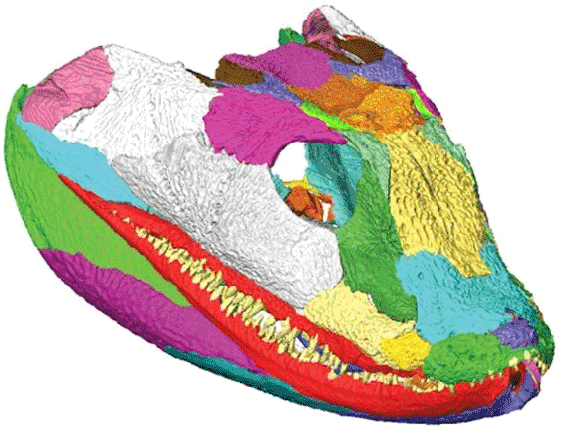Or was it overlooked?
(See Fig. 1, blinks organge/green above the orbit.)

Figure 1. Acanthostega skull from Porro et al. 2015 showing lack and presence of the intertemporal above the postorbital and between the postfrontal and supratemporal — or else it is fused to the parietal.
Ancestral osteolepiformes
like Osteolepis have an intertemporal. So do many (but not all) basal tetrapods. Porro et al 2015 did not indicate one (Fig. 1), but I have added a green one where I think one would be, dorsal to the postorbitals and lateral to the parietals. It blinks on an off in that animation. It might have been overlooked because the whole skull roof has shifted forward. Typically the intertemporal is located somewhat behind the orbit (Fig. 2), where the supratemporal is in figure 1.
Ventastega, a closely related taxon,
(Fig. 2, green added) indicates the presence of an intertemporal. Earlier an intertemporal was located in Ichthyostega where one was overlooked before.

Figure 2. Ventastega from Ahlberg et al. 2008, showing their interpretation of an intertemporal (green) above a missing postorbital.
Side note
Most Acanthostega relatives do not have such an elevated mandible tip. This hook-jaw morphology is similar to the spawning phase of the male sockeye salmon, which does not have such a hooked jaw in its ocean phase.
References
Ahlberg PE, Clack JA, Luksevics E, Bom H and Zupins I 2008. Ventastega curonica and the origin of tetrapod morphology. Nature 453: 1199-1204.
Clack JA 2006. The emergence of early tetrapods. Palaeogeography Palaeoclimatology Palaeoecology. 232: 167–189.
Clack JA 2009. The fin to limb transition: new data, interpretations, and hypotheses from paleontology and developmental biology. Annual Review of Earth and Planetary Sciences. 37: 163–179.
Coates MI 2014. The Devonian tetrapod Acanthostega gunnari Jarvik: Postcranial anatomy, basal tetrapod interrelationships and patterns of skeletal evolution. Earth and Environmental Science Transactions of the Royal Society of Edinburgh.
Coates MI and Clack JA 1990. Polydactly in the earliest known tetrapod limbs. Nature 347: 66-69.
Jarvik E 1952. On the fish-like tail in the ichtyhyostegid stegocephalians. Meddelelser om Grønland 114: 1–90.
Porro LB, Rayfield EJ and Clack JA 2015. Descriptive Anatomy and Three-Dimensional Reconstruction of the Skull of the Early Tetrapod Acanthostega gunnari Jarvik, 1952. PLoS ONE 10(3): e0118882. doi:10.1371/journal.pone.0118882

Uh. What? The picture you’re giving us is a 3-D reconstruction from CT data. The diagenetic distortion is no longer in there.
How do you hope to argue with a CT reconstruction if you haven’t downloaded the CT data and looked for sutures and breaks on your own?
You might be able to find the fusion surface if you look into the actual CT data. That’s how the fusion of the pleuro- and intercentra of Ichthyostega was discovered.
I repeat calling b-s.
In Acanthostega, however, the upper jaw still fits the lower jaw, quite unlike in any spawning-phase male salmon. And its body shape is quite unsuitable for endurance swimming.
Ooh, my comment has been censored. How cute!
My #animated #poem Adam the Acanthostega about the first lifeform to crawl onto land 400 yrs ago why did it bother? + İlave olarak Our new paper on cranial anatomy and function in Acanthostega. Congrats @LauraBPorro who did all the hard work
David, you do realize that a CT scan is colorless. And that the workers are painting the bones themselves on a monitor, sort of like DGS, only better. It’s okay if they miss a vestige that is in the process of fusion to another bone. That’s going to happen every so often.
re: the upturned jaw – we’re all grownups here. We’re not labeling this a spawning salmon homology. Since it is SO different from all other relatives, I thought I’d bring it up for discussion via comparison.
In a CT scan, you can see suture surfaces. In a good CT scan, you can even see fusion surfaces that are invisible from the outside, like those between the pleuro- and intercentra of Ichthyostega.
Why doesn’t it ever occur to you that you are the one who’s overlooking and misunderstanding things?
Evidently you don’t understand the difference between a question mark and a period.